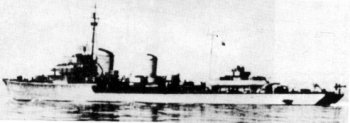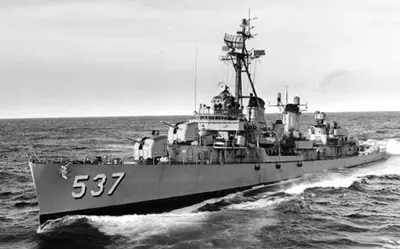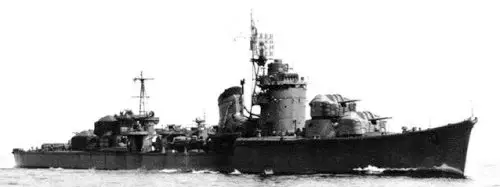The Best Destroyers of World War II By Chuck Hawks Torpedo boat destroyers, destroyers, or (slang) tin cans served all of the major sea powers well during WW II. They were the smallest, general purpose, ocean-going warships of the various blue water fleets and they often took heavy losses in action. That was perhaps inevitable, as destroyers were employed in many roles besides hunting torpedo boats and submarines, their original purposes. Destroyers were used to lay minefields outside of enemy harbors and to transport troops and supplies to beleaguered outposts in enemy controlled waters that were too dangerous for conventional transports to negotiate. They escorted convoys, provided air and gunfire support for larger and more vulnerable ships (such as troop transports and aircraft carriers), attacked superior enemy forces, bombarded invasion beaches well within the range of enemy shore batteries, scouted for their fleets and served as radar pickets far from the protection of friendly naval forces. They were expected to put themselves at risk to protect their charges, whether merchant ships or heavy warships. Destroyers fought submarines, aircraft and surface actions against all other classes of warships, from battleships to MTB's. Destroyers occasionally operated alone, but more often they were formed into flotillas or squadrons, which would then jointly be assigned a task, such as to escort a convoy, screen a task force, or to attack an enemy surface force with torpedoes and gunfire. Destroyers of all the major sea powers were lost during the war in the course of what were essentially suicide charges at far more powerful enemy surface ships. The courage and dedication of destroyer men clearly transcended national boundaries. Destroyers were viewed as expendable ships in both world wars and many of their brave crews paid the ultimate price. Excellent destroyers were designed and built for the navies of all the major sea powers during WW II. In this article, we will look at the best destroyers from Germany, France, Italy, Great Britain, the United States and Japan. Destroyers are multi-purpose warships, necessarily a blend of characteristics. The destroyer designs of the major sea powers often emphasized different ratios of these characteristics, based on their tactical requirements. Examples of some of these include habitability, sea keeping, range, speed, torpedo battery, main battery, anti-aircraft (AA) battery, anti-submarine (AS) weapons and so forth. Every destroyer had to strike a balance between these often contradictory requirements and it is not surprising that destroyers designed to operate on inland seas (the Baltic or Mediterranean, for example) differed from those designed to operate in the vast Pacific Ocean. We will try to note these differences as we examine the destroyers of the various navies. The U.S. Navy letter designation for destroyers is "DD" and for large destroyers "DL." These have subsequently been adopted by most naval writers and will occasionally be used here. The specifications used in this article were taken from Conway's All the World's Fighting Ships, 1922-1946. Germany  Powerful units on paper, the handsome, twin stack, German destroyers of the Second World War generally failed to perform to expectations. Some classes were armed with 5.9" (150mm) guns, but these guns proved to be too heavy and slow firing for many destroyer purposes, so the final class of German destroyers to see service, the 1936B type (launched 1942-1944), reverted to 5" main battery guns. These were carried in single mounts located in the A, B, Q, X and Y positions, much like the American Fletcher class. Unlike the American destroyers, which carried dual-purpose main battery guns, the German 5" mounts were designed for surface action only. The 1936B type were good-looking, balanced ships. They featured raised forecastles, Atlantic (clipper) bows and twin smoke stacks with funnel caps. The forward stack was about twice the diameter of the aft stack, a useful recognition feature. German steam turbine machinery operated at high pressure and proved unreliable during the war. One of the results was that, at sea, German destroyers were typically unable to achieve their rated speed. Designed primarily for operation in the Baltic and North Seas, their sea keeping qualities were often found lacking in the broad Atlantic, which further reduced their speed and combat usefulness. The number of AA guns on German destroyers was increased during the war and sometimes the "Q" main battery turret was removed and replaced by heavy AA guns although, as far as I know, this was not done to the 1936B type. Here are the specifications for the 1936B type destroyers.
The five ships of the 1936B class had unfortunate careers. While on a mine-laying mission, Z36 and Z36 ran afoul of an existing German minefield in the Gulf of Finland and sank on 12 December 1944. Z44 was bombed and sunk by the RAF while being outfitted at Bremen in July 1944. Z43 was scuttled in May 1945 and Z45 was damaged by RAF bombers while still on her building slip and never launched. France  Mogador and Volta constituted a two ship class that, in the event, were the final French destroyers completed before France was overwhelmed in 1940. These were exceptionally large and powerful ships, carrying eight 5.5" guns and 10-21.7" torpedo tubes on a full load displacement of some 4018 tons. Ships of this size and power would have been classed as light cruisers in many navies, but with a range of only 3000nm at 20 knots, they were indeed large destroyers (DL), incapable of fulfilling the primary cruiser role of cruising to distant shores. Their turbines developed 92,000 horsepower and their raised forecastles, clipper bows and 451' overall length made them decent sea boats and allowed them to achieve trials speeds well in excess of 40 knots at light displacement. Their director controlled main battery had a slow rate of fire (about six rounds per minute per gun) and proved unreliable in service. These were single purpose, surface action only, guns. This reduced their AA capability compared to contemporary American and Japanese destroyers. In addition, their ASW capability was limited. Thus, while (theoretically) powerful surface combatants, they were less effective as all-around destroyers than many of their contemporaries. Here are their specifications.
Both ships were scuttled at Toulon in November 1942, ending their brief careers. A further nine ships, incorporating improvements based on experience with the Modador class, were ordered, but work on these was not begun before the fall of France. Italy  The fleet destroyers of the Regia Marina served hard and well in the Mediterranean Sea during WW II. They usually fared poorly in night battles against the British, because (1) they lacked radar and (2) the Royal Navy had developed and extensively practiced night tactics before the war and the Italian Navy had not. Italian destroyers were to pay a high price for these oversights, but they fought bravely and doggedly. They helped keep the supply lines from Italy to Tunisia open so that the Axis army in North Africa could be maintained and they helped restrict Allied use of the central Mediterranean for most of the war, at least until the surrender of the Afrika Corps. The Regia Marina is seldom given the credit due for these accomplishments. The Maestrale, Oriani and Soldati classes represent the full development of the Italian WW II destroyer. The four ships of the Maestrale class, laid down in 1931 and completed in 1934, successfully incorporated the lessons learned from previous destroyer designs and the four Oriani (1935-1937) and 12+7 Soldati (1936-1942) classes were essentially repeat Maestrales with minor variations in machinery and armament. All of these ships carried at least four 120mm (4.7") main guns in twin mounts fore and aft plus six-21" torpedo tubes in two triple mounts. The second group of Soldati's generally carried an extra 4.7" gun in a single mount amidships. Being on the losing side in WW II, most of the Italian destroyers were ultimately sunk and the majority of the few surviving ships were assigned to victorious Allied navies as war reparations. Only three ships from the classes mentioned above survived the war to serve with the post-war Italian navy. Four others survived to be transferred to France and two were transferred to the USSR after hostilities ended. The rest were lost during the war, with submarine attack, air attack and gunfire being the most common causes. These were durable destroyers, however, and many times individual ships were able to bring their crews home after suffering considerable battle damage. Here are the specifications of the definitive Soldati class.
Visually, the design of these Italian destroyers incorporates a long, raised forecastle and a single large funnel behind the forward superstructure. Since they did not have true dual-purpose main batteries, unlike the Battle (UK), Fletcher (US) and Akitsuki (Japan) classes, they were deficient in AA guns and during the war the 13.2mm MG were replaced by from eight to a dozen 20mm AA guns in twin and single mounts. In some ships, the aft triple TT mount was replaced by one or two 37mm/54 AA guns. In general, these ships proved quite capable of holding their own against their British contemporaries in daylight surface engagements. Great Britain  British destroyers in WW II tended to be well-balanced, seaworthy ships; true multi-role vessels that were seldom the best for a specific purpose or in any single category, but competent in virtually all roles. Britain needed many destroyers to protect the numerous heavy ships of the Royal Navy, her merchant marine (the largest in the world at the beginning of the Second World War) and her far-flung Empire. This argued for large numbers of small to medium size destroyers, rather than a few large destroyers. British destroyers had to have good sea keeping qualities, because they operated under all conditions in all of the oceans of the world. It was a recurring theme during the war for British destroyers to torpedo large enemy ships in conditions so vile that the enemy destroyers that were supposed to screen their heavy ships had been sent back to port. This is exactly what happened to the German battleship Scharnhorst during her final battle off the North Cape of Norway. It was torpedoes from British (and one Norwegian) destroyers that reduced her speed and allowed the British battleship Duke of York and her companion cruisers to close the range and sink the Scharnhorst. Perhaps the most capable of the Royal Navy's destroyers were the vessels of the Battle class (so called because they were named for famous battles). These were large, late war destroyers intended primarily for use in the Pacific. They carried the fully developed version of the British 4.5"/45 QF Mk. III DP main battery guns, which were mounted in two twin turrets forward, eliminating the need for a 4.5" shell magazine aft. These ships had an improved fire control system and the main battery guns featured 80-degrees of elevation and fired a heavier shell that provided greater penetration than the 4.7", single purpose (surface action) guns found on earlier British destroyers. Weight and space are at a premium in all warships, but particularly in destroyers, so a true dual-purpose (heavy AA and surface action) main battery is a huge design advantage. These ships had the raked Tribal class bow shape and the high forecastle typical of British destroyers. The latter was carried aft of the forward superstructure to improve sea keeping qualities. There was a single large funnel, as with all British destroyers produced during the war. A generous fuel capacity meant longer range than was typical for European destroyers. Here is a summary of (1st Group) Battle class specifications.
The first group of Battle class destroyers (16 ships) were laid down between late 1942 and early 1944 and launched between November 1943 and September 1945. A follow-on batch of eight ships was launched between January 1945 and August 1945, but these were not completed until after the war. This second batch were provided with an additional, single 4.5" gun in a mount with 55-degrees elevation, located just aft of the funnel. A main battery of only four guns had been one of the few criticisms leveled at the original Battle class. There were also two extra torpedo tubes (2x5). Most of the Battle class ships served into the 1960's and some into the 1970's. Two were transferred to Pakistan in 1957 and one to Iran in 1967. None were sunk by enemy action during the war. Two additional ships, Anzac and Tobruk, were built in Australia after the war with a total of 18-40mm AA guns (3x4 and 6x1); these entered service with the Royal Australian Navy in 1950-1951. The Battle class DD's served the UK and her allies long and well and represent the zenith of WW II British destroyer design. United States  The American Fletcher class was the most numerous single class of destroyers built during the war, numbering some 151 ships of the original and improved types. This illustrates the esteem in which these excellent vessels were held. They served in both the Atlantic and Pacific theatres with distinction in almost every major battle from the beginning of 1943 onward and it is hard to see how the Pacific War could have been prosecuted without them. The Fletchers were the quintessential WW II American destroyers. They were long range, flush deck, twin funnel vessels with outstanding firepower. Construction of the (earlier) Benson class destroyers and the (later) Allen M. Sumner class continued concurrently with the Fletcher class, although the Fletchers were generally considered the best all-around ships. Here are the original specifications for the Fletcher.
The 5" main battery guns were an efficient, quick-firing, dual-purpose type that served equally well for surface actions and as heavy AA guns. As with most WW II destroyers, the light AA armament was increased during the war. The 1.1" guns were removed and the typical Fletcher class AA armament later in the war became five twin 40mm Bofors mounts and seven 20mm guns. Some ships in 1945 had one bank of torpedo tubes removed to compensate for replacing two of their twin 40mm gun mounts with quad 40mm mounts. Japanese Kamikaze planes had become the principal threat to U.S. destroyers and there were few Japanese surface combatants left to torpedo. 19 Fletcher class destroyers were sunk during the war and five more were so heavily damaged that they had to be scrapped. Of the survivors, many served in the Korean War and most were not stricken from the U.S. Navy list until the 1970's. A good number were transferred to the navies of various American allies and served for another decade or more. Four ships, including the Sullivans pictured above, have been preserved in the U.S. as war memorials. Japan  The Imperial Japanese Navy fielded fine, high speed, long-range destroyers during the Second World War. Their final heavy destroyers were the 16 units of the Akitzuki class, ordered as part of the 1939 and 1941 building programs. Twelve of these were actually commissioned. One ship, Mochitzuki, was not completed by war's end and three ships of the 1941 program were never begun. Some 40 additional units were proposed in various wartime supplementary building programs, but the resources to build them were not available. The Akitzuki class were formidable ships and arguably the finest destroyers of WW II. These large, seaworthy destroyers had a full load displacement of 3700 tons. They were designed primarily as AA destroyers and fielded a main battery of 8-3.9" (100mm) DP guns and (initially) a light AA battery of four 25mm guns. The 25mm AA battery was progressively increased to between 40 and 51 guns on surviving ships by the end of the war. They also carried a battery of four torpedo tubes for the deadly Japanese 24" Long Lance torpedoes and depth charge throwers, thus making them capable, all-around destroyers. These were impressive looking ships. They had a tower bridge, single trunked smoke stack, raised forecastle, clipper bow and a balanced armament layout, with their torpedo tubes mounted amidships and main battery guns in the A, B, X and Y positions. Here are their original specifications.
Of the 12 ships that entered service, six survived the war and six were sunk in action. Of the latter, one fell victim to an American submarine, two were sunk by U.S. Navy aircraft and three were lost in surface actions. One of the surviving ships was transferred to China after the war and one to the USSR. The Chinese ship, Fen Yang (ex-Yoitzuki), was not scrapped until 1963. The fate of the Soviet ship, renamed Pospeschny (ex-Harutzuki), is unknown. |